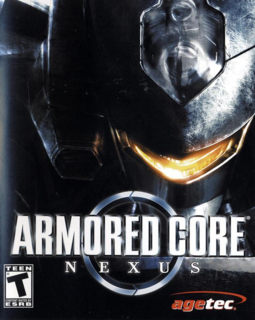perfect game for robot fans
Nexus lets you create your own robot from roughly 400 different parts.
Nexus comes packaged as a two-disc set. The first disc, titled "Evolution," contains 100 missions centered around the new story arc, which is merely a fast and loose plotline involving a mercenary for hire and his experiences working for rival mining corporations. Disc two, entitled "Revolution," contains 40 missions taken from previous installments in the Armored Core series that have been made over to take advantage of the new game's graphics engine and robot-design interface. This last disc also includes a litany of earned secrets, such as music, movie clips, emblems, posters, and concept artwork spanning the entire history of the franchise. Both discs offer a versus mode with support for up to four players, either by split-screen (on one PS2) or LAN setup (using four PS2s equipped with network adapters and four monitors). Surprisingly, neither disc has anything in the way of an actual Internet-based online mode. Ever since the PlayStation 2 network adapter was introduced, fans have been begging for an online-enabled Armored Core game, and it looks like they'll have to continue waiting.
The general gist of the new game is the same as those of the past. Players assemble a robot, called a "core," and then go out on missions to face enemy cores in ravaged areas or in arenas filled with spectators. Different missions are unlocked, and money is gained or lost depending on the outcome of each battle. Cores come in all shapes and sizes, which means you can put together just about any kind of robot your mind can conjure up. You can assemble bodies supported by humanoid legs, insect legs, quad legs, tank treads, or hover suspensions. You can attach weapons--such as guns, lasers, rocket launchers, and swords--to the arms and shoulders of your robot. Then you can accessorize the whole thing with thrusters, cooling systems, and radar units. Finally, you can take the end product out on to the battlefield to see how well it fares.
Experienced Armored Core vets will find themselves right at home with the game's sluggish controls. Walking, stopping, and turning all incorporate slight response delays based on the theory that a 10-ton robot has a fair amount of weight and momentum acting on it. Meanwhile, other factors, such as recharge time, reloading, and recoil, have an influence over the overall accuracy and usefulness of weapons during battle. Nexus isn't a complete rehash, however. The controls have been changed to a dual analog piloting system that's more in line with traditional first-person shooters. As a result, the left stick causes the robot to walk, and the right stick controls the steering and aiming functions. Firing and weapon-selector controls are situated on the shoulder buttons, while the face buttons are used for dropping weapons and activating internal systems. Newcomers may be overwhelmed at first, both by the intricate controls and the slow-paced handling of the robots--not to mention the glut of more than a dozen onscreen displays. However, the trade-off is that the game totally makes you feel like you're in charge of every aspect of your robot's travels. Players that want to use the classic control setup can still do so by enabling it from the option menu.
Various weapons and systems can be attached to the arms, shoulders, and back of your core, or they can be tucked inside its torso.
While the new control interface might suggest that developer From Software is trying to attract players who haven't had much experience with the franchise, it's sure made a bunch of other changes that suggest longtime AC vets will have an easier time acclimatizing to Nexus than newbies will. The time limits and destruction quotas that underpin most missions have been made stricter, and the design of each mission calls for a lot more planning. Some missions require the use of sniper weapons just to hit enemy targets, while others set up melee situations where machine gun and blade weapons work best. Still others emphasize the use of thrusters and jamming systems over all-out gunplay. Enemy cores also carry better weapons and armor this time around, and they're much smarter, too. Rival cores will boost into the air and duck behind structures to avoid your shots. They'll jerk side-to-side to make it tougher to lock on to them, set you up for two-on-one situations, and won't hesitate to close in for the kill if your armor runs low.
These improvements combine to make Nexus more difficult and more interesting than its predecessors, which is great. However, the one thing the developer failed to do, in turn, was revamp the mission briefings to make them appropriately informative and helpful. Mission briefings don't tell you how many enemies you'll be facing or the kinds of weapons they'll be carrying, and they don't offer advice on the kinds of weapons you should equip for the mission. Since new missions open up and old ones disappear based on your success or failure during a mission, you can't just attempt the same mission over and over again until you get it right. It would've been nice to at least have had some warning when faced with a mission specifically oriented around sniping or fast aerobatics

